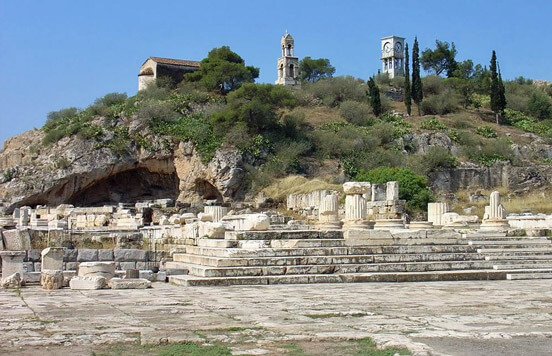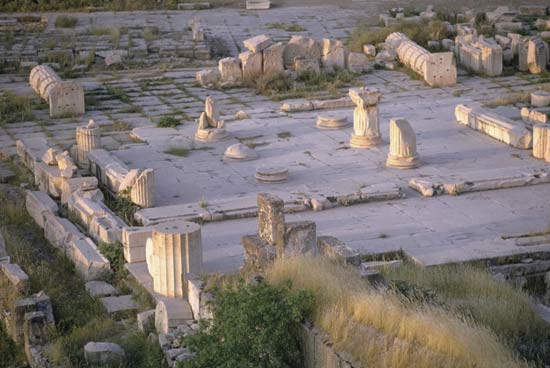
Eleusis

Brief Overview
It is best known for having been the site of the Eleusinian Mysteries, one of the most famous religious events of the ancient Greek religion, and the birthplace of Aeschylus, one of the three great tragedians of antiquity.
From as early as 1700 BC up to the 4th century AD, Eleusis was the site of the Eleusinian Mysteries, or the Mysteries of Demeter and Kore. These Mysteries revolved around a belief that there was a hope for life after death for those who were initiated.
Such a belief was cultivated from the introduction ceremony in which the hopeful initiates were shown a number of things including the seed of life in a stalk of grain.
The central myth of the Mysteries was Demeter's quest for her lost daughter (Kore the Maiden, or Persephone) who had been abducted by Hades.
It was here that Demeter, disguised as an old lady who was abducted by pirates in Crete, came to an old well where the four daughters of the local king Keleos and his queen Metaneira (Kallidike, Kleisidike, Demo and Kallithoe) found her and took her to their palace to nurse the son of Keleos and Metaneira, Demophoon.
Demeter raised Demophoon, anointing him with nectar and ambrosia, until Metaneira found out and insulted her. Demeter arose insulted, and casting off her disguise, and, in all her glory, instructed Meteneira to build a temple to her.
Keleos, informed the next morning by Metaneira, ordered the citizens to build a rich shrine to Demeter, where she sat in her temple until the lot of the world prayed to Zeus to make the world provide food again.

In Detail
Eleusis
Settlement around the bay and plain of Eleusis began in the Bronze Age, c.1900 BCE, on the Thriasian plain, specifically, on the slopes of the east hill in the southwest corner. From the 16th century BCE the summit was inhabited, and in the 15th century BCE a temple to Demeter was first built coinciding with the reign of the legendary King Celeus, who first founded a sanctuary to the goddess in Homeric tradition. The name of the town derives from the mythical hero Eleusis, whose father was Ogygos, king of Thebes.
In the 7th century BCE Eleusis, always strategically important on the route to the Peloponnese, merged with Athens and became the deme of the tribe (phyle) of Hippothontis. In the 6th century BCE fortifications were constructed to enclose the Akris hill and sanctuary of Demeter and Persephone (Kore). The fortress was, along with Panakton and Phyle, one of the most important fortresses in Attica. There was also an important theatre of Dionysos constructed at the site. The most important festival at Eleusis was the annual Mysteries, which were famed throughout the Greek world, and c. 600 BCE they became an official ceremony in the Athenian calendar. Solon also aggrandized the site adding a new temple, the Telesterion (also known as the Solonian or Anaktoron for the inner, most sacred room), and enlarging the sacred precinct. During the reign of Pisistratus (550-510 BCE) Eleusis benefitted from the Pisistratan fortification wall with towers and a much larger Telesterion to better accommodate the ever-growing numbers of initiates to the Mysteries.
The site was destroyed during the Persian invasion of 479 BCE but rebuilt under Cimon. Another round of rebuilding was carried out in the 5th century BCE under Pericles, allowing Eleusis to boast the largest building in Greece when the Telesterion was rebuilt on an even bigger scale. Escaping any damage during the Peloponnesian War, the site was again expanded c. 360 BCE, which necessitated a larger protective wall, the "Lycurgan" Wall. At the same time the 6th century BCE Plutoneion building was replaced by a larger structure and the Portico of Philo added.
Besides the Mysteries (see more below), other important festivals at Eleusis during the Archaic and Classical periods included the Eleusinia (an important biannual games where the prizes were sacred grain), Thesmophoria (an all-female autumn festival in honour of Demeter when pigs were thrown into pits and left to putrefy; their remains were then mixed with seeds before sowing), Haloa (another largely all-female winter festival in honour of Demeter and Dionysos), Kalamaia, and the Proerosia.
In Hellenistic times a Macedonian garrison was stationed at Eleusis, and the Romans, starting with Hadrian, revamped the sanctuary from the early 2nd century CE and added a triumphal arch. Disaster struck when the Telesterion was destroyed in 170 CE by the Costobocs. The temple was rebuilt during the reign of Marcus Aurelius (161-180 CE), and the Roman emperor also oversaw the construction of a monumental gate, an exact copy of the Propylaea of the Athenian acropolis. Other Roman additions included a gymnasium, hostels, and baths. The sanctuary's fortunes declined significantly following the decree of Theodosius I to close down all pagan sites in 379 CE, and Eleusis was destroyed around 395 CE following the invasion of the Visigoths. The town continued to exist for a few more centuries, but the glory days when she enjoyed Pan-Hellenic stature were never to be regained.
[1]
The Eleusinian Mysteries
Demeter, the goddess of nature, had a daughter, Kore, who was kidnapped and, by some accounts, raped, by Hades, lord of the underworld. Demeter searched for her Kore all across the earth in vain, finally coming to rest by a well in the city of Eleusis. There, disguised as an old woman, she cared for the queen's son, baptizing him nightly in fire so that he would be immortal. When the queen, one night, found her nursemaid placing her son in the fire she was understandably upset - but not as angry as the grieving goddess who then threw off her disguise and revealed her glory and her wrath. Mollified, as long as the people would build her a temple in Eleusis, Demeter taught the queen's son, Triptolemos, the art of agriculture. Zeus, king of the gods, persuaded Hades to return Kore to her mother as, in Demeter's grief, the crops were dying, people starving, the gods not receiving their accustomed tribute. Hades agreed but had tricked Kore into eating some pomegranate seeds and, if one ate in the land of the dead, one remained with the dead. As she had only eaten some, however, it was agreed she would spend half the year with Hades in the underworld and half with her mother on earth. Kore emerged from the underworld as Persephone (`she who brings doom') the Queen of the dead and, while she remained on earth, Demeter caused the world to be fruitful while, when Persephone was in the underworld, the plants withered and died; thus the seasons were explained.
There were the Lesser Mysteries, which took place in the spring, and the Greater Mysteries which those who had been purified earlier took part in when September came. They walked the Sacred Way from Athens to Eleusis calling for the Kore and re-enacting Demeter's search for her lost daughter. At Eleusis they would rest by the well Demeter had rested by, would fast, and would then drink a barley and mint beverage called Kykeon. It has been suggested that this drink was infused by the psychotropic fungus ergot and this, then, heightened the experience and helped transform the initiate. After drinking the Kykeon the participants entered the Telesterion, an underground `theatre', where the secret ritual took place. Most likely it was a symbolic re-enactment of the `death' and rebirth of Persephone which the initates watched and, perhaps, took some part in. Whatever happened in the Telesterion, those who entered in would come out the next morning radically changed. Virtually every important writer in antiquity, anyone who was 'anyone', was an initiate of the Mysteries.
[2]
Official Website and Map
Further Sources
[1] "Ancient History Encyclopedia"
[2] "Ancient History Encyclopedia"
"Ancient Greece"
"Encyclopaedia Brittanica"
"Eleusina"
Our Mobile Application
Check out Our Mobile Application "Ancient Greece Reloaded"


